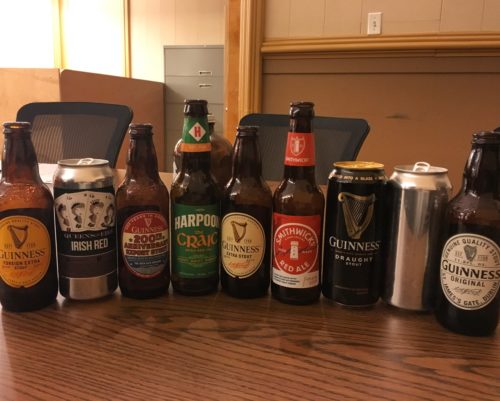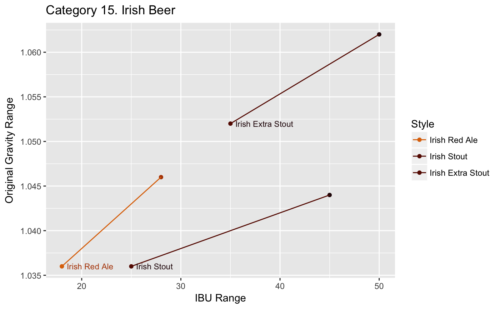BJCP Study Group: Category 15
¶ by Rob FrieselSession #22 was for Category 15, Irish Beer — a.k.a., “How many kinds of Guinness would you like to try?”
Category 15. Irish Beer
Of the Irish Beers, the BJCP style guide says: (emphasis mine)
The traditional beers of Ireland contained in this category are amber to dark, top-fermented beers of moderate to slightly strong strength, and are often widely misunderstood due to differences in export versions, or overly focusing on the specific attributes of beer produced by high-volume, well-known breweries. Each of the styles in this grouping has a wider range than is commonly believed.
| 15A. Irish Red Ale | 15B. Irish Stout | 15C. Irish Extra Stout |
|---|---|---|
| 18 – 28 IBU | 25 – 45 IBU | 35 – 50 IBU |
| 1.036 – 1.046 O.G. | 1.036 – 1.044 O.G. | 1.052 – 1.062 O.G. |
| 1.010 – 1.014 F.G. | 1.007 – 1.011 F.G. | 1.010 – 1.014 F.G. |
| 3.8 – 5.0% ABV | 4.0 – 4.5% ABV | 5.5 – 6.5% ABV |
At a glance, there is not a lot (aside from the Irish heritage) that links all three styles together. None of them are particularly defined by the yeast. In each case, hop aroma is described as “typically absent”, and when present is usually “earthy or floral” or else “earthy or spicy”. Most examples of all three styles will have a characteristically dry finish; and to that end, roasted grain character is typical. The two stout styles appear to have quite a bit in common, with some subtle differences that correspond with the scaling strength; it’s the Irish Red Ale that’s the odd one out. In this post, I’ll skip over any in-depth discussion of all three styles — suffice it to say, all three are largely malt-focused ales with a roasted grain aspect and a usually dry finish.
We kicked things off with little fanfare, except to note that it would be a three scoresheet night, as we would do our “training exercise” with a particular focus on delivering speculative feedback. (It is also worth noting here that three of us remarked on being “handicapped” for the session, one coming down with a cold, another in the middle of one, and [myself] getting over one.)
- 15A. Irish Red Ale. Smithwick’s Red Ale. 1 Judged/scored; structured tasting. The group’s consensus score was 37, and tightly clustered there (36-38) with two outliers giving 41 each. When discussing “points off”, there seemed to be two themes. First: most perceived the balance as too bitter for the style, with some speculation that it was a variation brewed for the American market. Second: there didn’t seem to be quite enough of a caramel note in the flavor — and while the style guide does indicate that quality as “moderate to very little”, we also discussed the tendency to index more on aspects of a style given how early those aspects show up in the description. We also had two open questions about this beer. First: what role might diacetyl play in the “light buttery character” that is mentioned? And how does one go about fighting the urge to ding that as a fault? Second: how does a minerally water profile fit in to a style like this (where minerally examples seem common) when that isn’t called out in the style guide?
- 15C. Irish Extra Stout. Guinness Extra Stout. Judged/scored; structured tasting. We did not cluster tightly with this beer, and the scores ranged from the mid-30s to the low-40s; we didn’t arrive at a consensus score. On the one hand, people that scored low tended to remark that it lacked complexity and that it was overly astringent. Those that scored high observed layers of chocolate and mocha and vanilla, and perceived the astringency level to be appropriate, such that it didn’t interfere with the smoothness. Polarizing.
- Scoring and feedback exercise. Our coordinator for the night had pulled the labels off a couple of cans and sent them around. 2 “Score it as a 22A — Double IPA.” It was evident to everyone (even those of us that were otherwise “impaired” from our colds) that this was a flawed beer, though it was difficult to pin down exactly how. Descriptions from around the table included “overly grassy”, “harsh”, “dull”, and “estery” — among others. We speculated on the sources of these faults and converged on three likely things: (1) over-hopping with “old” hops, (2) stressed and possibly late-generation yeast, and (3) oxidation somewhere along the way. Scores ranged from 28 (“What? I have a cold!”) to 15 (“I don’t even know where to begin with how bad this is.”); consensus score settled on 20.
- 15B. Irish Stout. Guinness Draught Stout. Not scored; casual tasting. The classic Guinness draught can. Everyone at the table was familiar with this one. We didn’t not talk about it, but we were mostly still talking about the flawed beer.
- 15A. Irish Red Ale. Rurban Brewing Queens of Eire. Not scored; casual tasting. An interesting contrast to the Smithwick’s from earlier in the evening. More malty-sweetness, more of the caramel that we’d expect. But also that slightly more diacetyl than “light buttery” should allow. Spitball scoring was low to mid-30s.
15A. Irish Red Ale.22B. Specialty IPA: Red IPA. Harpoon “The Craic” Irish Red IPA. Not scored; casual tasting. Interesting to compare this one to the 15A examples from the evening. It was decidedly a Red IPA and not an Irish Red Ale, but the inspirations were evident with the color, the body, and the grainy dry finish.- 15B. Irish Stout. Original Guinness. Not scored; casual tasting. Perceived as noticeably stronger than the Draught can, and noticeably richer or more complex than the Extra Stout. (But at this point we were sort of… just trying to get through what was left.)
- 15C. Irish Extra Stout. Guinness 200th Anniversary Export Stout. Not judged; casual tasting. “Wait… didn’t we judge this before? But as 16D?” Yes, we did.
- 15C. Irish Extra Stout. Guinness Foreign Extra Stout. Not judged; casual tasting. “Basically an Irish Imperial Stout.”
- Bonus beers. Two of us had brought in some homebrews that we were prepping for competition and needed feedback on, especially with respect to the question: “How would you position this in a specialty category? Using what style as the base beer?” Which is in and of itself a fun exercise.
Takeaways
- Don’t forget to consider the source of faults. When filling out a scoresheet, don’t just comment on a fault. Speculate on how it might have gotten there and provide corrective feedback. That said, bear in mind that you’re speculating, so position that feedback as a suggestion.
- Where is the line between a minor and major flaw? In the context of the Irish Red Ale and the oft-mentioned (though optional) “very light buttery character”, diacetyl seems to be the most likely source. However, diacetyl is not explicitly mentioned as the source of this character. So if one detects a buttery aspect, that would imply some level of diacetyl. And in this case, it would be acceptable — but where is the line before it crosses over into inappropriate? Presumably the rubric to follow is “when it becomes unpleasant” — but if we apply that broadly, we can conclude that even some styles that should not have any diacetyl could be faulted only moderately as long as the beer remains pleasant to drink. Granted, there’s a big difference between a beer like an Irish Red Ale where just-over-the-limit diacetyl might only cost a point or two, and a scenario where you have just-perceptible diacetyl in a Munich Helles where it has a bigger impact.
- ”Pronounced smid-icks, you philistines.”[↩]
- He later told us what it was but, for the sake of being gentlemanly about it, we’ll allow these brewers to remain anonymous for now. No need to give them a bad reputation unfairly.[↩]


Leave a Reply